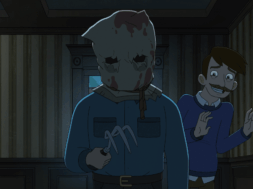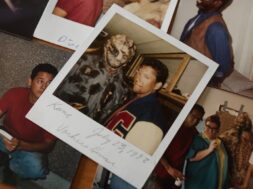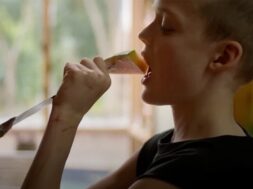A meteor crashes to Earth, emits strange colors in the perimeter around the crash, and begins altering the flora and fauna in bizarre ways that defy Earthbound science. In H.P. Lovecraft’s popular short story “The Colour Out of Space”, the strange alien meteorite affects a farm near the coast with “colour,” indescribable globules of color that taints and alters everything around the crash site. In Alex Garland’s Annihilation, the meteor crash near the coast unleashes the “Shimmer,” an iridescent dome of color that has irrevocably changed everything inside it. For Lena (Natalie Portman) and the expedition sent to investigate the Shimmer, their journey is nothing like the horrific decay of the Gardner farm in Lovecraft’s story, but they reach very similar conclusions. And that looming fear of the unknown feels very much in line tonally, as well. Annihilation isn’t based on Lovecraft’s works at all, and yet it feels like the greatest adaptation among his most popular stories; the story that’s garnered more adaptations than any other in Lovecraft’s catalog.
Among Lovecraft’s personal favorites of his work, “The Colour Out of Space” was the first in which he blended sci-fi with horror. Lovecraft’s brand of horror emphasizes the unknowable, usually in the form of indescribable monstrosities, and a whole lot of unanswered questions that leave a lingering feeling of dread. It allows a lot of room for interpretation, and yet Lovecraft’s stories have proven very difficult to adapt. But “The Colour Out of Space” puts its focus on the Gardner family, through the eyes of their neighbor Ammi Pierce, who recounts the colour’s changes of the Gardners to a land surveyor from the city. The story may have referred to the glowing colors of the meteorite as “almost impossible to describe,” but it gets precise with the description of the squirrels, rabbits, woodchuck, cabbages, asters, and other common ecology that are morphed and warped into something horrific. The horror comes from twisting the familiar into something grotesquely unknown, making it hit much closer to home than a lot of his works. It’s the relatability and familiarity that makes “The Colour Out of Space” work, and ripe for consistent adaptations.

The first was 1965’s Die, Monster, Die! Directed by Daniel Haller, this adaptation is very loosely based on Lovecraft’s story and adheres closer to the Edgar Allan Poe film series by Roger Corman that kicked off the decade. Haller served as production designer for many of the Corman produced Poe films, which no doubt played a major factor in his look and feel for Die, Monster, Die! Boris Karloff stars as Nahum Witley, a wheelchair-bound scientist that discovers a radioactive meteorite and keeps it in his basement, using it to mutate the plants and animals in his greenhouse. Save for some of the names, the core effect of the meteorite, and certain character fates, this is furthest removed from Lovecraft’s story.
It took almost twenty years for another cinematic attempt at “The Colour Out of Space” to come along, this time an Italian-American production directed by actor David Keith (An Officer and a Gentleman, Firestarter) and co-produced by Lucio Fulci. Set in the present, The Curse is a much more faithful take on the story, though it does devolve into an insane creature feature by the third act. Starring a young Wil Wheaton and his sister Amy Wheaton as the only two Crane family members not infected by the meteorite that’s crash-landed on their Tennessee farm, they watch in horror as the crops, then livestock, and finally, their family members mutate. It’s a showcase of gory, gooey, ‘80s effects, of which Fulci also contributed, and made enough of an impact to earn an unrelated sequel.

In 2008, Colour from the Dark marked another loose adaptation of the story. Starring Debbie Rochon, this story also followed a farm and its inhabitants as they descend into chaos after a strange color appears from their well. But there’s no meteor crash or cosmic horror in this adaptation, just a supernatural based entity and themes of religious horror.
The most faithful take yet came two years later, with German film The Colour Out of Space, or Die Farbe. The plot has a man traveling to Germany in search of his missing father, and uncovering the secrets of the land where he was stationed after World War II. Save for that setting update, it plays out almost exactly like Lovecraft’s story. With its low budget, director Haun Vu makes an interesting style choice- The Colour Out of Space is in black and white. Though puzzling at first, aside from hiding some of the rougher CG effects, it makes the appearance of the “colour” pop.
These films are just the straightforward feature length adaptations, and doesn’t even touch upon the impact “The Colour Out of Space” played on meteorite-based horror. The Blob, “The Lonesome Death of Jody Verrill” segment of Creepshow, Slither, and many more draw influences from Lovecraft’s story in some capacity. Almost always in more rural settings, all see the alien horror consume and spread across the land, be it creature, radiation, or blight. Annihilation subverts that by turning the alien destruction into a thing of beauty, but the core similarities remain the same. It’s the most well-executed take on Lovecraft’s story yet, but the possibilities are limitless and leave the door wide open for more perspectives on Lovecraft’s cosmic “colour.”










